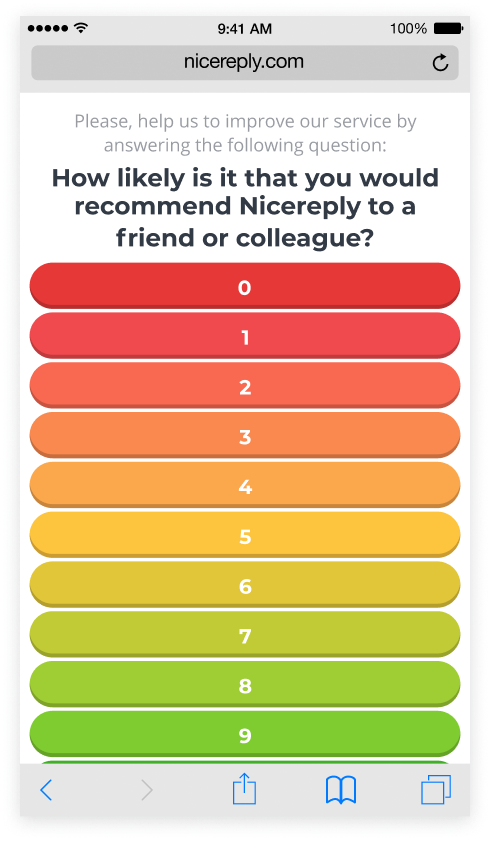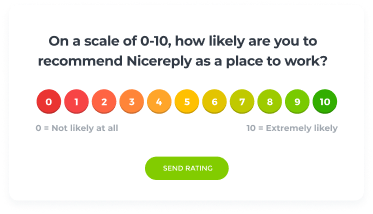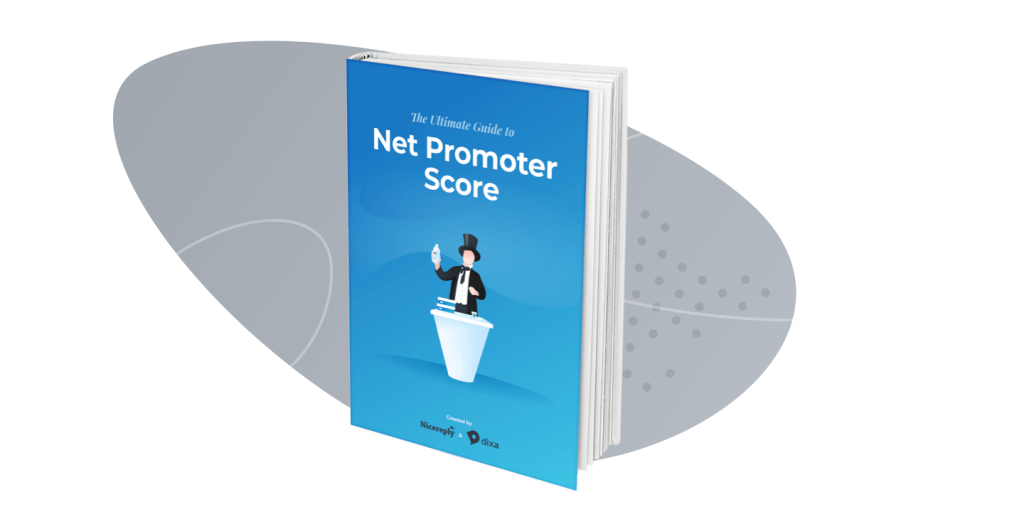What is a Net Promoter Score (NPS)? Tracking this metric is one of the most important things you can do for your business.
What’s the one number your business needs to grow?
You might think it’s revenue—with good reason.
While revenue is undoubtedly crucial, it’s only a part of the equation. Growing revenue can be a short-term strategy that brings immediate gains, but focusing on customer loyalty is vital for long-term, sustained growth and success.
Many argue that the real game-changer is the Net Promoter Score (NPS).
NPS unlocks the door to customer loyalty, organic growth, and the true potential for lasting success.
Here’s how.
- What is NPS score?
- How to calculate your NPS score [formula]
- What NPS means for your business
- What is a good NPS score? [NPS scores by industry]
- Potential pitfalls of NPS
- NPS scores fluctuate
- How to use NPS effectively
- Encourage survey participation and response rates
- Follow up with open-ended questions
- Segment and analyze the data
- Tie NPS to actionable goals
- Track trends in NPS over time
- Use NPS as part of a broader feedback strategy
- A feedback strategy that works
What is NPS score?
NPS stands for Net Promoter Score. It’s one of today’s most widely used metrics to measure customer loyalty.
The NPS score is calculated with one simple question. Customers are asked,
“On a scale of 0 to 10, how likely are you to recommend our company or product to a friend or colleague?”
Based on their responses, customers are classified into three categories:
- Promoters (score 9–10): These are delighted and loyal customers who will likely recommend the company to others.
- Passives (score 7–8): These customers are generally satisfied but less enthusiastic than Promoters. They’re considered neutral and might be easily swayed by competitors.
- Detractors (score 0–6): Dissatisfied customers who are likely to spread negative opinions about a company, potentially harming their reputation.
How to calculate your NPS score [formula]
The NPS formula looks like this:
NPS = Percentage of Promoters – Percentage of Detractors
In other words, it’s calculated by subtracting the percentage of Detractors from the percentage of Promoters. The score can range from -100 (all customers are Detractors) to +100 (all customers are Promoters).
A positive score indicates that there are more Promoters than Detractors, while a negative score means the opposite.
Here’s an example. A company’s NPS survey responses might look like this:
- 60 customers are promoters, scoring 9–10.
- 20 customers are passives, scoring 7–8.
- 20 customers are detractors, scoring 0–6.
Out of 100 customers, 60% are promoters, and 20% are detractors. That means their NPS score is +40.
60% Promoters – 20% Detractors = NPS of +40
What NPS means for your business
NPS was popularized by Frederick Reichheld in an article titled The One Number You Need to Grow, published by Harvard Business Review.
It fulfills a unique role in metrics that a company might work with.
Ultimately, the NPS score is a measure of customer sentiment. But it isn’t only a measure of sentiment. It provides a way for companies to predict customer behavior, such as their likelihood of making a repeat purchase or referring a product to their friends.
That’s where the real power of NPS lies.
Reichheld’s research suggests that the percentage of customers who are enthusiastic enough about a product to refer it to a friend or colleague directly correlates with growth.
And this has been supported by multiple studies since:
- A tenfold increase in NPS score correlates with a 3.2% increase in upsell revenue.
- Around 80–90% of referrals come from promoters.
- Detractors are responsible for over 80% of negative word of mouth.
This doesn’t mean that NPS is a perfect Key Performance Indicator (KPI), nor does it mean that chasing a high NPS score is the right thing for every company. NPS isn’t guaranteed to correlate with growth—but by and large, it does.
In most industries, it remains the single most effective question to ask that will give you a snapshot of customer sentiment in a way that implies loyalty—the kind of loyalty that has a direct impact on your bottom-line metrics.
What is a good NPS score? [NPS scores by industry]
Unsurprisingly, NPS scores vary wildly by industry.
Looking at your absolute NPS score independent of the industry you’re in is a fool’s errand. A score of +30 might be fantastic in some sectors and abysmal in others. Benchmarking against similar companies is the best way to contextualize your score.
SurveyMonkey broke down NPS across three industries:
- Professional services (legal, financial) had a median NPS of +50.
- Technology companies (telecommunications, and computer manufacturers) had a median NPS of +40.
- Consumer goods and services (retailers, restaurants) had a median NPS of +50.
Retently did similar research, looking at B2B and B2C companies. There may be other NPS score categories:
- Internet software & services had the lowest average NPS score of +9.
- Insurance had the highest in the B2C space, with an average score of +27.
- NPS in B2B companies is significantly higher, where cloud & hosting is the lowest performing category with an NPS average of +39.
Any positive score is a good sign because you have more promoters than detractors, but your industry’s norms dictate what target you should set.
Potential pitfalls of NPS
Like all metrics, NPS has some drawbacks.
When used in isolation, NPS can become a vanity metric—something that looks and feels good but doesn’t drive meaningful actions or translate to results in your business. The trick is to use it with additional context.
These are the top four shortcomings of NPS:
- Passives aren’t considered in the NPS score.
- Even a stable NPS can mask underlying problems.
- NPS scores fluctuate.
- NPS alone is not actionable.
Passives aren’t considered in the score
Passives don’t directly count towards the NPS score.
That results in many companies neglecting those respondents. The tendency is to aim to reduce the proportion of detractors or increase the proportion of promoters—and simply ignore the passives.
Even if passives aren’t directly represented in the score, a high proportion of passives restricts how high your total NPS can get. And it will likely take less effort to turn someone who’s passive about your brand into a promoter than it would to turn a detractor around.
Even a stable NPS can mask underlying problems
Say your NPS survey distribution looks like this:
- 20% are promoters.
- 70% are passives.
- 10% are detractors.
Your NPS score would be +10.
Next time you run an NPS survey, the numbers shift a little. Now you’re looking at:
- 40% promoters.
- 30% passives.
- 30% detractors.
Your NPS score is still +10, and you’ve doubled your promoters, which is great. But you’ve also tripled your detractors, and that’s a big red flag.
A stable NPS score might give the impression that customer sentiment toward your product is the same as it was before. In this scenario, sentiment towards your product has become significantly more extreme than it used to be—in both directions.
The point is that looking at the number alone is not enough.
NPS scores fluctuate
Like most KPIs, NPS is influenced by many factors, like seasonality, product launches, and marketing campaigns.
Some amount of noise is normal, and the amount that’s considered normal will vary from business to business. It also depends on your response rates and sample sizes.
A sudden decrease might not reflect an actual change in customer sentiment or loyalty. Companies that rely too much on NPS as a metric might pivot and respond to minor changes too fast and too early.
NPS alone is not actionable
An NPS survey says nothing about what needs to change or what you can improve.
At the end of the day, what you have is a number. That number indicates areas you might need to look into, but that’s the most it can do.
When a customer rates your product or service higher, you can track the change, but the NPS survey isn’t enough to know why. It doesn’t deliver actionable insights. To actually address feedback, you’ll likely need to track additional data and combine it with qualitative insights as well.
Start your day
with great
quality
content
How to use NPS effectively
The shortcomings of NPS don’t mean that there isn’t room to use it.
It’s a valuable tool for the majority of businesses. It’s especially useful because there’s so much industry-specific benchmarking data available for it.
Here are some ways to make the most of an NPS survey:
- Encourage survey participation and response rates.
- Follow up with open-ended questions.
- Segment and analyze the data.
- Tie NPS to actionable goals.
- Track trends in NPS over time.
- Use NPS appropriately as part of a broader feedback strategy.
Encourage survey participation and response rates
All surveys become more reliable and more meaningful with higher response rates. NPS is no different.
Here are some ways you can increase your response rate:
- Find the right frequency. Sending surveys too often will increase the likelihood of people ignoring it or getting frustrated by it.
- Send it at the right time. Ideally, it would be sent after someone has interacted with your product (e.g., purchased something) or with your service (e.g., through support). But there should also be enough of a gap that the case is fully resolved, or the customer’s had time to really use your product.
- Engage and address customer feedback. People are always more likely to respond to something when they realize there’s someone on the other end who really cares about their thoughts.
- Make it as easy as possible. Use tools that let you capture feedback instantly without asking for a ton of information or making your customers click around. Instant Ratings on Nicereply do just that.
- Use an engaging subject line. If you’re sending your NPS survey via email, the subject line makes a huge difference.
It’s so much easier to leverage NPS and invest resources here when you can trust the insights that you’re pulling.
Follow up with open-ended questions
Go for the right nps score question. Open-ended questions are a simple way for your customers to tell you what’s on their minds in their own words. They’ll likely give you a few good hints about where to focus your energy if you want to improve your NPS score.
Collecting any qualitative insights does mean a bigger time investment when analyzing the data, but that time is well-spent if it translates to actions.
Note that making your survey longer will hurt your response rate—so there’s always a tradeoff to be made.
You’re choosing between getting more answers with less depth or fewer answers that might give you actionable insights. Your choice will depend a lot on what other sources of data you might have. If you can already supplement your NPS data with other insights, it might not be worth it.
Segment and analyze the data
There are a million ways to segment NPS data to get better insights.
You can segment based on:
- Customer demographics, like age or gender. This can help you see where your product already performs the best and which demographics might need something different.
- Customer type, which would involve differentiating between repeat customers and new customers. Understanding how different customer groups perceive your brand and their loyalty levels can guide targeted retention and acquisition strategies.
- Customer journey touchpoints, like presales, purchase, onboarding, or post-purchase. Pinpointing areas with low NPS scores within the customer journey can help prioritize improvements.
- Customer feedback themes. You might notice some recurring issues that most detractors mention or that promoters often reference one or two features.
Segmentation is ultimately about finding the right opportunities for the right customer groups.
Tie NPS to actionable goals
Having access to mountains of data is great! Translating that data into actions is extremely challenging.
Tracking NPS just to know where your business sits is still worth it. If your NPS seems stable over time and you’re happy with where you are in comparison to your industry, there’s no reason to make huge changes.
That said, NPS is most effective when you set concrete and actionable goals. Ideally, these goals should also be tied to your company’s broader goals.
Some examples might look like this:
- Increase promoters or reduce detractors by x%.
- Improve the NPS score at a key customer touchpoint.
- Turn x% of passives into promoters.
- Increase the customer retention rate by x% (using NPS as a potential lever).
Track trends in NPS over time
Your NPS score might tell you a little about customer sentiment.
How that score changes and develops over time tells you so much more.
An increase in NPS scores over time is a great sign for your business. And an increase in the proportion of promoters, especially if it stays consistent over a longer period, is an even better one. Promoters are:
- More than 4x as likely to repurchase from a company.
- More than 5x as likely to forgive a company if it makes a mistake.
- More than 7x as likely to try new offerings from the company.
Monitoring changes in NPS can also help you see the impact of any improvements you’ve made.
Remember that the score isn’t absolute, though. Even if there’s a positive change but you see a dramatic increase in the proportion of detractors, you should still look into it.
Use NPS as part of a broader feedback strategy
NPS is only one metric. It has its place, but other metrics might be more suitable depending on what you’re looking for.
NPS is intended to measure customer sentiment towards your company or brand as a whole.
- If you want to measure a specific support interaction, CSAT might be a better option. CSAT is useful to assess satisfaction at specific touchpoints or moments in the customer journey.
- Another option might be CES if you want to reduce the effort that customers are spending. Higher CES scores indicate a smoother and more effortless customer experience.
If you want to get more specific, NPS data might not provide all the information you need.
Having trouble deciding between NPS vs. CSAT? To get the most out of both, read our article.
A feedback strategy that works
NPS is a powerful metric that goes beyond measuring customer satisfaction—it measures customer loyalty. Incorporating it into a broader feedback strategy creates an opportunity for you to understand your customers’ sentiments, needs, and preferences.
The good news? Nicereply provides an effortless way to get started with NPS. Your customers can give you feedback in just one click, while you collect meaningful feedback for your business.
Want to dive even deeper first? Check out our free ebook on NPS here!










